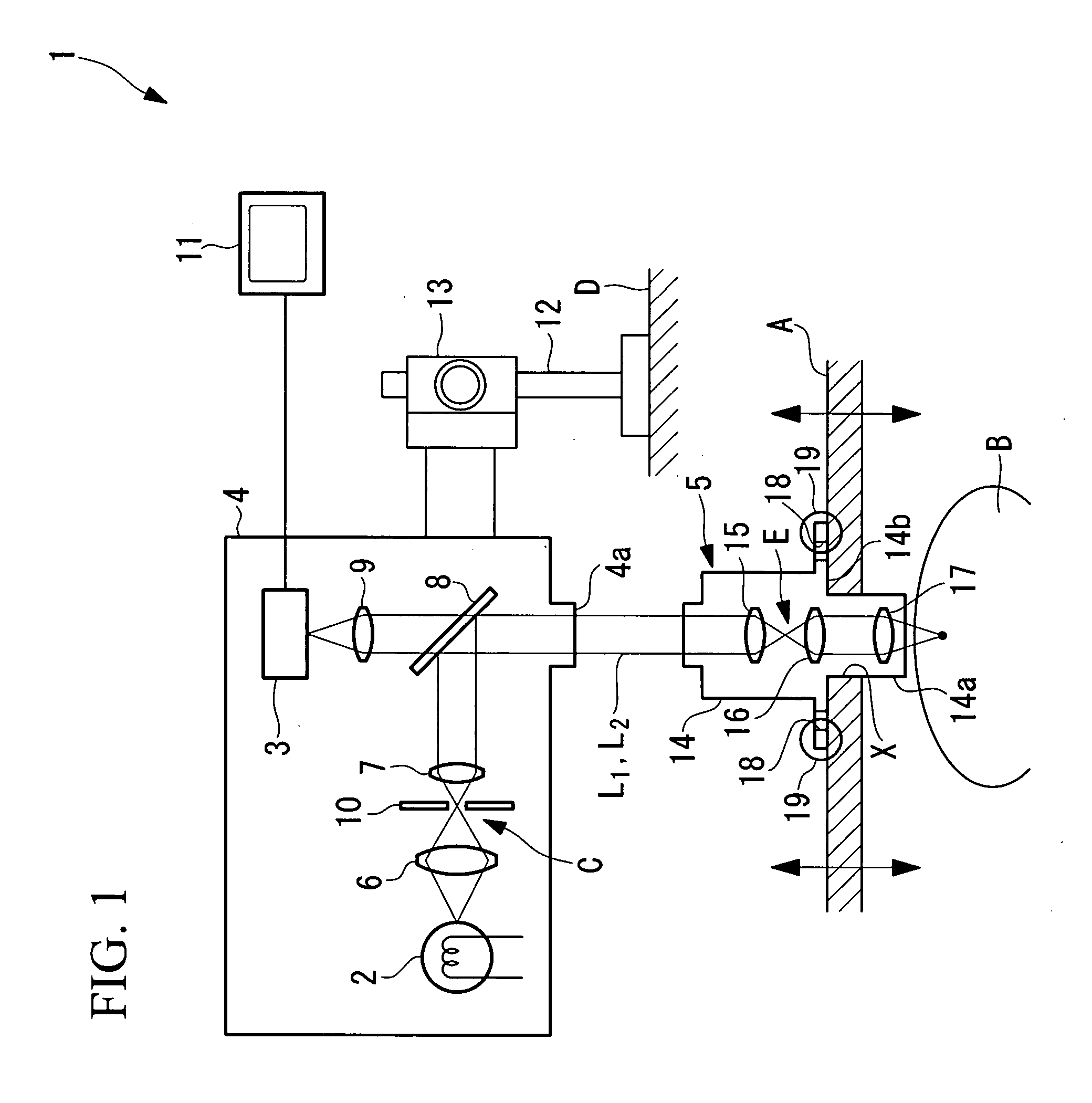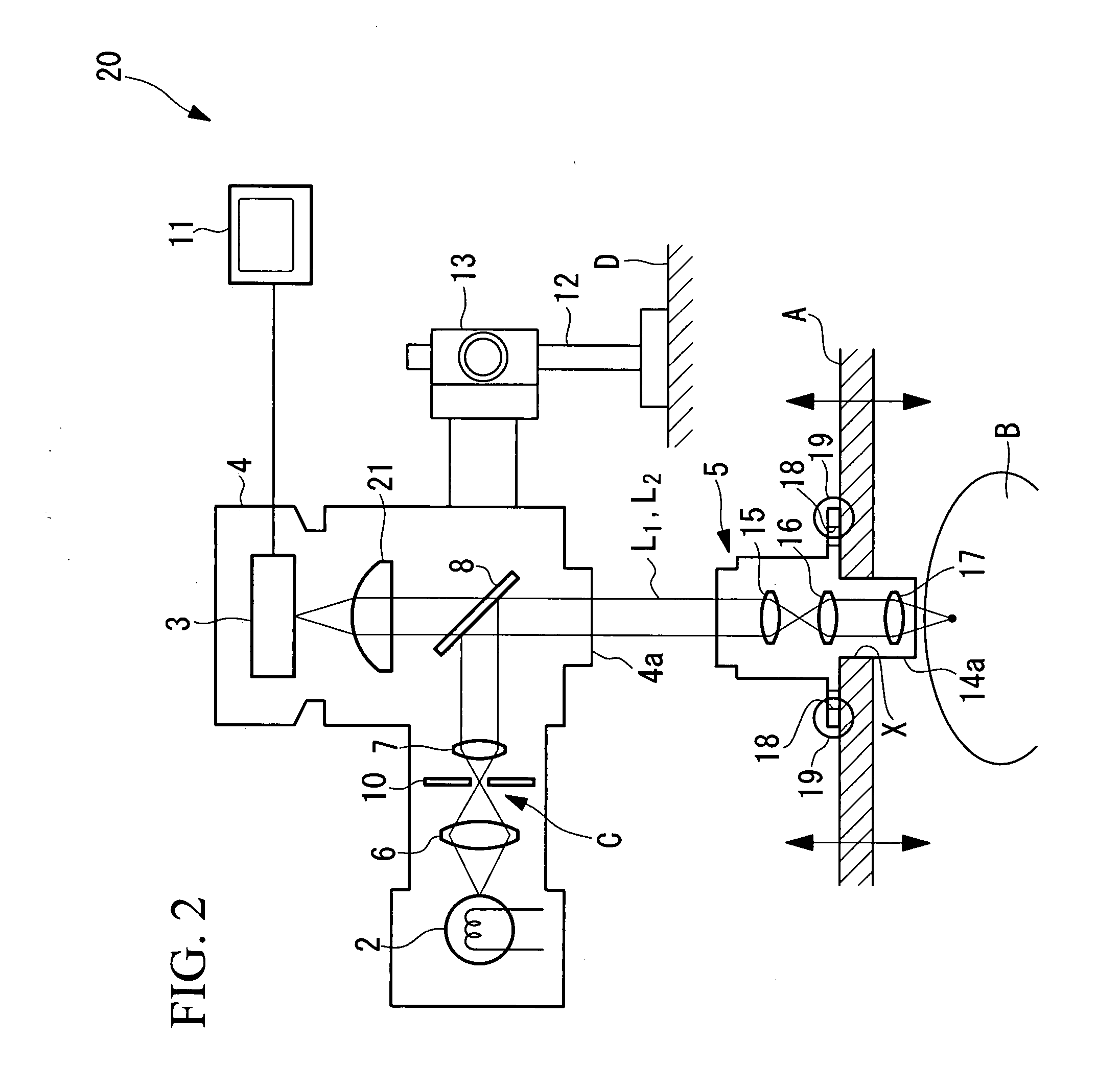In-vivo examination apparatus
a microscope and apparatus technology, applied in the field of in-vivo examination apparatuses, can solve the problems of not being able to obtain sufficient information for observation, not being able to carry out observation with the microscope photography apparatus, and being difficult to observe, etc., to achieve the effect of not causing blurring of images
- Summary
- Abstract
- Description
- Claims
- Application Information
AI Technical Summary
Benefits of technology
Problems solved by technology
Method used
Image
Examples
first embodiment
[0033]An in-vivo examination apparatus 1 according to the present invention will be described below with reference to FIG. 1.
[0034]As shown in FIG. 1, the in-vivo examination apparatus 1 according to this embodiment includes an optical unit 4 provided with a light source 2 for emitting illumination light and an image-acquisition device (for example, a charged coupled device: CCD) 3; and an observation head 5, which is secured to a living organism A such as a laboratory animal, for receiving light emitted from the optical unit 4 and illuminating an observation target site B in the living organism A, as well as for emitting return light from the living organism A towards the optical unit 4.
[0035]The optical unit 4 includes a focusing lens 6 for focusing light from the light source 2 to form an intermediate image C, a collimator lens (first collimator optical system) 7 for collecting light forming the intermediate image C and collimating it, a half mirror 8, and a focusing lens 9 for f...
second embodiment
[0048]Next, an in-vivo examination apparatus 20 according to the present invention will be described with reference to FIG. 2.
[0049]In the description of this embodiment, parts having the same configuration as those in the in-vivo examination apparatus 1 according to the first embodiment described above are assigned the same reference numerals, and a description thereof is omitted.
[0050]As shown in FIG. 2, the in-vivo examination apparatus 20 according to this embodiment differs from the in-vivo examination apparatus 1 of the first embodiment in that, the image-forming lens for imaging the return light on the image-acquisition device 3 is formed of an fθ lens 21.
[0051]According to this embodiment, when the collimated light L2 returning from the observation head 5 is introduced into the optical unit 4 via the opening 4a, it is transmitted through the half-mirror 8 and is imaged by the fθ lens 21. Accordingly, an image of the examination target site B is acquired by the image-acquisit...
third embodiment
[0054]Next, an in-vivo examination apparatus 30 according to the present invention will be described below with reference to FIG. 3.
[0055]In the description of this embodiment, parts having the same configuration as those in the in-vivo examination apparatus 1 according to the first embodiment described above are assigned the same reference numerals, and a description thereof is omitted.
[0056]As shown in FIG. 3, the in-vivo examination apparatus 30 according to this embodiment includes an optical unit 33 including a laser light source 31 and a light detector 32; an optical fiber 34 for transmitting laser light from the laser light source 31 and fluorescence to the light detector 32; a scanning unit 35 for two-dimensionally scanning the laser light transmitted by the optical fiber 34; and an observation head 5 which is fixed to a living organism A, such as a laboratory animal.
[0057]A collimator lens 36, a dichroic mirror 37, and focusing lenses 38 and 39 are provided in the scanning ...
PUM
 Login to View More
Login to View More Abstract
Description
Claims
Application Information
 Login to View More
Login to View More - R&D
- Intellectual Property
- Life Sciences
- Materials
- Tech Scout
- Unparalleled Data Quality
- Higher Quality Content
- 60% Fewer Hallucinations
Browse by: Latest US Patents, China's latest patents, Technical Efficacy Thesaurus, Application Domain, Technology Topic, Popular Technical Reports.
© 2025 PatSnap. All rights reserved.Legal|Privacy policy|Modern Slavery Act Transparency Statement|Sitemap|About US| Contact US: help@patsnap.com



